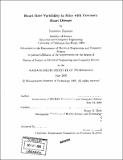| dc.contributor.advisor | Roger G. Mark. | en_US |
| dc.contributor.author | Zapanta, Laurence (Laurence F.) | en_US |
| dc.contributor.other | Massachusetts Institute of Technology. Dept. of Electrical Engineering and Computer Science. | en_US |
| dc.date.accessioned | 2006-09-28T15:04:54Z | |
| dc.date.available | 2006-09-28T15:04:54Z | |
| dc.date.copyright | 2005 | en_US |
| dc.date.issued | 2005 | en_US |
| dc.identifier.uri | http://hdl.handle.net/1721.1/34118 | |
| dc.description | Thesis (S.M.)--Massachusetts Institute of Technology, Dept. of Electrical Engineering and Computer Science, 2005. | en_US |
| dc.description | Includes bibliographical references (leaves 69-71). | en_US |
| dc.description.abstract | Heart rate variability (HRV), the beat-to-beat fluctuation of the heart rate, is a non-invasive test that measures the autonomic regulation of the heart. Assessment of HRV has been shown to predict the risk of mortality in patients after an acute myocardial infarction. Recently, the Krieger lab at MIT developed genetically engineered double knockout (dKO) mice that develop coronary artery disease accompanied by spontaneous myocardial infarctions and die at a very young age. This thesis investigated whether HRV could function as a prognostic indicator in the dKO mouse. A novel method for estimating physiological state of the mouse from the electrocardiogram using an innovative activity index was developed in order to compare HRV variables at different times while controlling for physiologic state. Traditional time and frequency domain variables were used to assess the prognostic power of HRV. Results have shown that none of the HRV variables were helpful in predicting mortality in the dKO mice. Mean heart rate showed some prognostic power, but it was not consistent in all the dKO mice. Finally, the activity index developed in this thesis provided a reliable metric for activity in mice as validated by a camera with motion detection. | en_US |
| dc.description.statementofresponsibility | by Laurence Zapanta. | en_US |
| dc.format.extent | 71 leaves | en_US |
| dc.format.extent | 3413200 bytes | |
| dc.format.extent | 3416100 bytes | |
| dc.format.mimetype | application/pdf | |
| dc.format.mimetype | application/pdf | |
| dc.language.iso | eng | en_US |
| dc.publisher | Massachusetts Institute of Technology | en_US |
| dc.rights | M.I.T. theses are protected by copyright. They may be viewed from this source for any purpose, but reproduction or distribution in any format is prohibited without written permission. See provided URL for inquiries about permission. | en_US |
| dc.rights.uri | http://dspace.mit.edu/handle/1721.1/7582 | |
| dc.subject | Electrical Engineering and Computer Science. | en_US |
| dc.title | Heart rate variability in mice with coronary heart disease | en_US |
| dc.title.alternative | HRV in mice with coronary heart disease | en_US |
| dc.type | Thesis | en_US |
| dc.description.degree | S.M. | en_US |
| dc.contributor.department | Massachusetts Institute of Technology. Department of Electrical Engineering and Computer Science | |
| dc.identifier.oclc | 67618309 | en_US |
